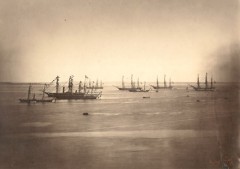by Alex Novak
There has been and probably always will be a strong market for this 19th-century photographer. Besides being an acknowledged master by virtually every art institution, he is one of the 19th-century equivalents to Ansel Adams. His images are very safe material. Any owner of a decorator-done house or office would be happy to have one of his beautiful seascapes on a prominent wall, and I do not say that in a derogatory way. He was also a very powerful image-maker. Only American landscape photographers such as Carleton Watkins and William H. Jackson have similar 19th-century cachet in this broad market. Hence, there will be a ready market for most reasonably priced Le Grays of quality.

A classic Le Gray seascape
Likewise, there is a high-end to this market for the rarest images or rarer print qualities of less rare images (that are dramatic images). Le Grays certainly will continue to command and get six figures, but it is clear that not every Le Gray will make it into this rarified atmosphere.
While not exactly a test of the Le Gray market, some other auction results indicate that the inflated numbers from the first Jammes sale and the Craven sale need to be put into perspective. This is an artist where clearly both rarity of image AND condition/quality of print is crucial in determining price.

An example of an early Le Gray-Mestral print
Probably the rarest of Le Gray images are those from his work on the Mission Héliographique with his friend O. Mestral. Most were done about 1851 and are in institutional collections. Their distinctive greenish black color is highly sought after by true Le Gray aficionados. His forest of Fontainebleau series can also be quite scarce. His marine work comes up the most frequently, but is also the most sought after by collectors.
Rarity may not even be the main factor, but demand may be even more important at times. Witness the recent record prices for Adams' Moonrise, perhaps the most printed art photograph of the 20th century. Even Le Gray's less rare images, such as the Brig on the Water, the Said Leaving Cette Harbor, the Breaking Wave, or even the record-setting Great Wave, will normally command strong prices with top prints, although the latter's $800,000-plus record at Jammes was clearly an aberration. Many of these prints were printed in the hundreds according to available records. How many survive in marketable prints is, of course, another story.
More and more attention on this artist will certainly result in more demand. For instance the Bibliotheque Nationale's and the J.Paul Getty Museum's fine Le Gray show has focused more attention on this artist, and two new books have been published on his work: not only Ken Jacobson's recent and very well researched book available through Carl Mautz cmautz@nccn.net in the U.S. and Ken Jacobson ken@jacobsonphoto.com in Europe and elsewhere, but also the new book by the Bibliotheque Nationale, which accompanied its show and was revised slightly and reprinted in English by the J. Paul Getty Museum.
Le Gray is certainly one of the two or three most important photographers of the 19th century and as such will draw great institutional interest. Any museum collecting photography from its beginnings must have a great Le Gray. Likewise many serious collectors will seek out his work, helping to push demand, and hence prices, up in the long term.
Novak has over 42 years experience in the photography-collecting arena. He is a long-time member and formally board member of the Daguerreian Society, and, when it was still functioning, he was a member of the American Historical Photographic Society. He organized the 2016 19th-century Photography Show and Conference for the Daguerreian Society. He is also a long-time member of the Association of International Photography Art Dealers. Novak has been a member of the board of the nonprofit Photo Review, which publishes both the Photo Review and the Photograph Collector, and is currently on the Photo Review's advisory board. He was a founding member of the Getty Museum Photography Council. He is author of French 19th-Century Master Photographers: Life into Art.
Novak has had photography articles and columns published in several newspapers, the American Photographic Historical Society newsletter, the Photograph Collector and the Daguerreian Society newsletter. He writes and publishes the E-Photo Newsletter, the largest circulation newsletter in the field. Novak is also president and owner of Contemporary Works/Vintage Works, a private photography dealer, which sells by appointment and at exhibit shows, such as AIPAD New York and Miami, Art Chicago, Classic Photography LA, Photo LA, Paris Photo, The 19th-century Photography Show, etc.

Share This